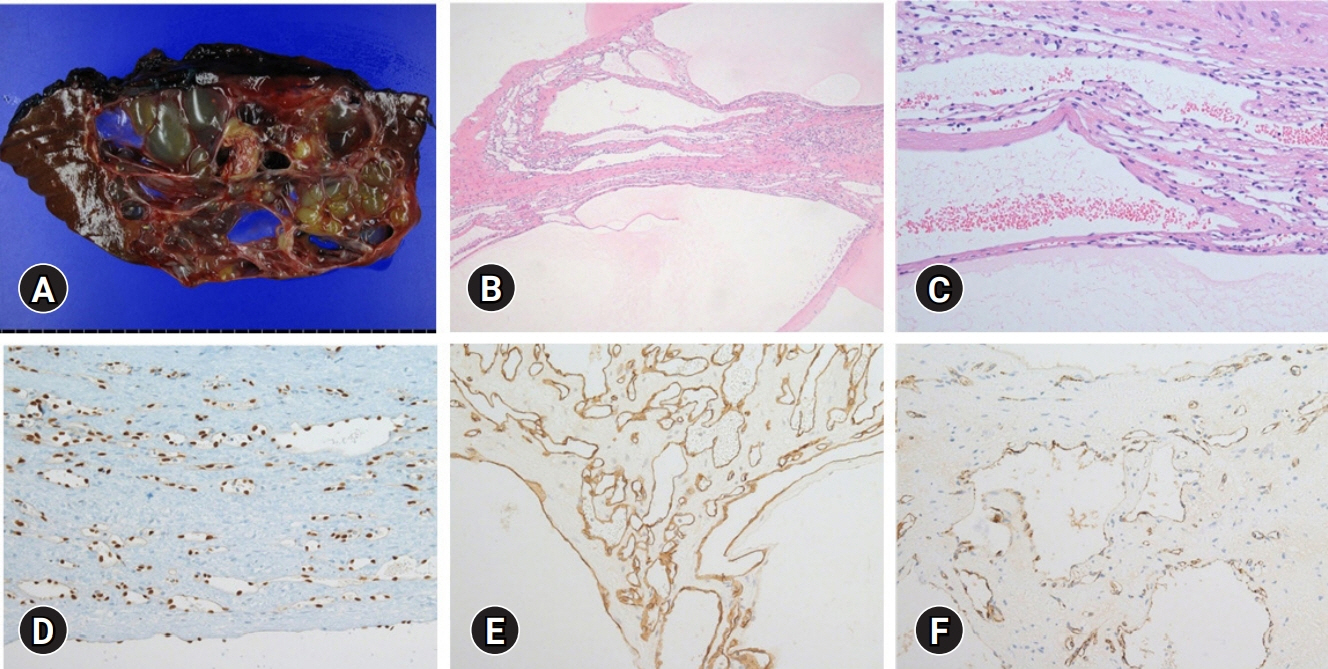J Yeungnam Med Sci.
2022 Jan;39(1):53-57. 10.12701/yujm.2021.00969.
Multilocular cystic hemangioma of the liver mimicking mucinous cystic neoplasm: a case report
- Affiliations
-
- 1Department of Radiology, Biomedical Research Institute and Pusan National University Hospital, Pusan National University School of Medicine, Busan, Korea
- 2Department of Pathology, Biomedical Research Institute and Pusan National University Hospital, Pusan National University School of Medicine, Busan, Korea
- 3Department of Surgery, Biomedical Research Institute and Pusan National University Hospital, Pusan National University School of Medicine, Busan, Korea
- KMID: 2525028
- DOI: http://doi.org/10.12701/yujm.2021.00969
Abstract
- Hepatic hemangiomas infrequently exhibit atypical imaging features, which may cause diagnostic confusion with hepatic malignancies and lead to unnecessary surgery. We report a rare case of multilocular cystic hemangioma of the liver mimicking a mucinous cystic neoplasm of the liver in a 48-year-old female, focusing on computed tomography and magnetic resonance imaging features and their differential diagnosis.
Keyword
Figure
Reference
-
References
1. Caseiro-Alves F, Brito J, Araujo AE, Belo-Soares P, Rodrigues H, Cipriano A, et al. Liver haemangioma: common and uncommon findings and how to improve the differential diagnosis. Eur Radiol. 2007; 17:1544–54.2. Klotz T, Montoriol PF, Da Ines D, Petitcolin V, Joubert-Zakeyh J, Garcier JM. Hepatic haemangioma: common and uncommon imaging features. Diagn Interv Imaging. 2013; 94:849–59.3. Vilgrain V, Boulos L, Vullierme MP, Denys A, Terris B, Menu Y. Imaging of atypical hemangiomas of the liver with pathologic correlation. Radiographics. 2000; 20:379–97.4. Jang HJ, Kim TK, Lim HK, Park SJ, Sim JS, Kim HY, et al. Hepatic hemangioma: atypical appearances on CT, MR imaging, and sonography. AJR Am J Roentgenol. 2003; 180:135–41.5. Hihara T, Araki T, Katou K, Odashima H, Ounishi H, Kachi K, et al. Cystic cavernous hemangioma of the liver. Gastrointest Radiol. 1990; 15:112–4.6. Hussain MZ, Ohtomo K, Hihara T, Uchiyama G, Ainoda T, Yamamoto M, et al. Multilocular cystic hemangioma: CT and MR appearance. Radiat Med. 1992; 10:206–9.7. Nakachi A, Shiraishi M, Shimoji H, Tomori T, Oshiro T, Muto Y. Multicystic cavernous hemangioma of the liver: report of a case including diagnostic imaging and pathologic correlation. Radiat Med. 1998; 16:209–12.8. Cha EY, Kim KW, Choi YJ, Song JS, Cho KJ, Lee MG. Multicystic cavernous haemangioma of the liver: ultrasonography, CT, MR appearances and pathological correlation. Br J Radiol. 2008; 81:e37–9.9. Qian LJ, Zhu J, Zhuang ZG, Xia Q, Liu Q, Xu JR. Spectrum of multilocular cystic hepatic lesions: CT and MR imaging findings with pathologic correlation. Radiographics. 2013; 33:1419–33.10. Borhani AA, Wiant A, Heller MT. Cystic hepatic lesions: a review and an algorithmic approach. AJR Am J Roentgenol. 2014; 203:1192–204.
- Full Text Links
- Actions
-
Cited
- CITED
-
- Close
- Share
- Similar articles
-
- Large, Multilocular Cystic Mass in the Uterine Cervix Mimicking Adenoma Malignum
- A case of multilocular cystic renal cell carcinoma mistaken for multilocular renal cyst
- Pedunculated mucinous cystic neoplasm of the liver: a case report
- Multilocular Cystic Renal Cell Carcinoma: A case report
- Oncocytic Type Intraductal Papillary Mucinous Neoplasm Mimicking Mucinous Cystic Neoplasm of the Pancreas: A Case Report




